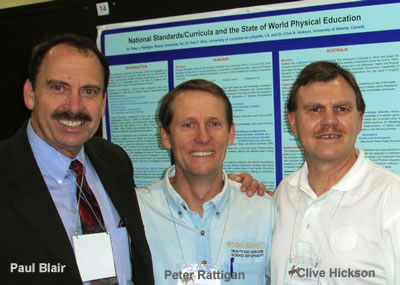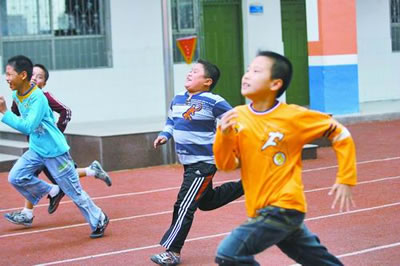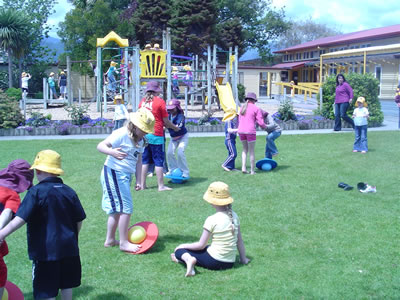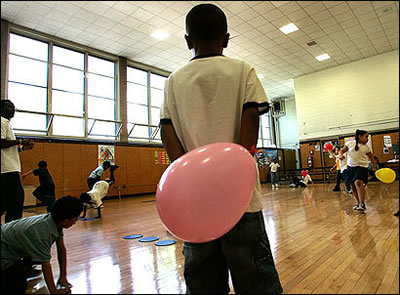|
 INTERNATIONAL
APPROACHES TO PHYSICAL EDUCATION: A
COMPARISON
Written by:Peter
Rattigan, PhD, Paul
Blair, PhD, & Clive
Hickson, PhD. INTERNATIONAL
APPROACHES TO PHYSICAL EDUCATION: A
COMPARISON
Written by:Peter
Rattigan, PhD, Paul
Blair, PhD, & Clive
Hickson, PhD.
As the United States has moved towards
a standards-based approach to education,
including physical education (PE), we
have been interested in looking at how
other countries approach their physical
education curriculum and instruction.
The U.S. has no national curriculum.
Each state is responsible for its academic
standards, and each discipline has developed
national standards. Many U.S. states
follow the National Association of Sport
and Physical Education National Standards
(NASPE, 2004).
States differ – for example some
states have specific PE standards (e.g.,
Utah, California), others combine Health
and PE (e.g., New Jersey), while others
include more (New York includes consumer
science). Even the nomenclature
differs (New Jersey has “content
standards” and “progress
indicators;” California has “model
content standards”). State mandates
or requirements for physical education
vary widely.
Physical education in the U.S. is,
for the most part, taught by certified
physical education teachers, although
classroom teachers may be found teaching
elementary physical education. According
to NASPE, a quality PE program should
be taught by a certified physical education
specialist, provide opportunities for
all students to learn, and have meaningful
content and appropriate instructional
practices (NASPE,
2004). NASPE recommends 150 minutes
per week for elementary and 225 minutes
per week for secondary classes.
This article presents national approaches
to physical education in five different
countries around the world. China and
Scotland are similar to the United States
in that they follow a national standards
approach. New Zealand, Hungary, and
Jamaica each have a national curriculum.
Each country is described in terms of
its approach (national standards/national
curriculum), underlying concepts, key
aspects of learning, implementation,
and resource provision.
 China:
National Standards China:
National Standards
The China Law of Physical Education
and Sport (China
Ministry of Education, 1995)
established 7 mandates with which schools
must comply:
- PE is a regular part of school
education.
- PE classes
are listed as academic courses that
are regularly assessed and sufficient
to meet the needs of special students.
- Time must
be allocated for students to participate
in physical activities every day to
meet national fitness standards.
- A variety
of after-school activity programs,
training, and sports competitions
are provided; annually, a school-wide
physical activity and sport meet is
conducted.
- Physical
educators need to be qualified according
to national regulations and should
receive benefits related to the job
specifications.
- Physical
activity fields, facilities, and equipment
must be used for physical activities
only.
- Student
physical examinations must be given,
and administrative supervision for
the improvement of students’
fitness must be provided.
 China
has developed national standards in
part based on U.S. standards (NASPE,
1995). In 2001 the China Ministry
of Education (CME) published the first
set of national standards for physical
education and health, based on student
outcomes and ensuring that all students: China
has developed national standards in
part based on U.S. standards (NASPE,
1995). In 2001 the China Ministry
of Education (CME) published the first
set of national standards for physical
education and health, based on student
outcomes and ensuring that all students:
- Are physically fit, demonstrate
competency in many movement forms,
and obtain knowledge and skills of
physical activities and health.
- Participate
regularly in physical activity.
- Demonstrate
communication and cooperation among
people.
- Demonstrate
individual responsibility for personal
and community health and exhibit a
healthy lifestyle.
- Achieve
a positive life attitude from physical
education (from
Liang, Walls & Lu, 2005).
Key
Aspects of Learning
The China standards are similar to NASPE
standards, paralleling a “Westernized”
trend in Chinese sport (China.org,
2004). Unlike NASPE standards,
the China national standards include
both PE and Health. NASPE and China
standards emphasize movement skills
and concepts, fitness, personal responsibility,
and a healthy and active lifestyle.
China standards also address participation,
communication, and cooperation; NASPE
addresses diversity, enjoyment, challenge,
and self-expression.
Implementation
There is considerable political support
for physical education in China:
- It is mandated that physical education
be provided to grades one through
12.
- Satisfactory
completion of physical education is
a requirement for advancement to the
next grade level and for graduation.
Administrative sanctions can be applied
to schools that fail to provide one
hour of physical activity each day,
including at least three after-school
physical activity sessions and two
physical education classes each week.
- Officially,
if a student fails to participate
for one-third of the total class hours
in one semester, he/she cannot be
given a passing score and will not
be considered as achieving the PE
requirements for graduation. He/she
can only receive a learning certificate,
and as such will not qualify for higher
education (China
Education and Research Network, 2001).
The PE mandates
are very positive and protective of
physical education (and sport) as a
core part of the school curriculum.
However, implementation has been inconsistent:
- The scale of implementation is
daunting. In China, 200,000,000 children
in grades one through 12 receive physical
education programming in 540,000 schools
(People's Education
Press, 2002).
- Rural schools
tend to have less funding but more
physical education classes per week
than urban schools. Qu (1998) found
that 87% of schools in larger towns
provided physical education classes
two times or more per week. In smaller
country towns, 82% provided classes
two times or more each week.
- Wang et
al. (2001) reported that elementary
and secondary schools provided physical
education two or more times each week
in 86% of cities, 92.7% of towns,
and 100% of rural areas in the Shandong
province (on China's more developed
east coast). Rural areas usually have
more elementary schools, fewer middle
and high schools, and larger class
sizes than urban areas. Rural school
pupils received more physical education
classes per week despite the fact
that the average per-pupil funding
each year in the Shandong province
was less for rural areas (28¢)
than for towns (64¢) and cities
($1.05).
Teacher
qualifications are an issue in implementation
(Liang et al,
2005):
- Less than a third of China’s
PE teachers have bachelor’s
degrees (30%) or above (1% have graduate
degrees). Fifty-eight percent of physical
educators have associate degrees;
twelve percent have only a high school
diploma.
- According
to China’s Law of Educators,
elementary teachers should hold a
diploma from a three-year teacher
training school, where graduates from
secondary school can go if they do
not wish to go to high school or college
but want to teach. Middle school teachers
should hold a degree from a 2-3 year
teacher college or earn a bachelor’s
degree; high school teachers should
earn a bachelor’s or master’s
degree.
- There are
height and fitness requirements for
entrance to PE teacher training programs,
as well as age (22 or younger) and
marital status (unmarried).
- PETE programs
include traditional content but little
in the way of teaching methodology,
motor development/learning, or diversity.
However, field experience and student
teaching are required.
Scotland: National
Standards (With National Curriculum
Elements)
 Scottish
education (Learning
and Teaching Scotland, 2008)
does not follow a national curriculum,
but rather a series of guidelines that
have elements of national curriculum
and national standards. Physical education
is part of the of the “Learning
and Teaching Scotland” (LTS) program.
LTS is a non-departmental, government
sponsored organization responsible for
supporting and developing public education
curriculum. Physical education is part
of the “5-14” curriculum
initiative in LTS, supporting primary
education through the first two years
of secondary education. Physical education
is a subject within Expressive Arts,
along with Art & Design, Music,
and Drama. Health Education is a separate
subject area. Scottish
education (Learning
and Teaching Scotland, 2008)
does not follow a national curriculum,
but rather a series of guidelines that
have elements of national curriculum
and national standards. Physical education
is part of the of the “Learning
and Teaching Scotland” (LTS) program.
LTS is a non-departmental, government
sponsored organization responsible for
supporting and developing public education
curriculum. Physical education is part
of the “5-14” curriculum
initiative in LTS, supporting primary
education through the first two years
of secondary education. Physical education
is a subject within Expressive Arts,
along with Art & Design, Music,
and Drama. Health Education is a separate
subject area.
Underlying
Concepts
The purpose of the Expressive Arts is
to promote pupils’ affective,
physical, cognitive, personal, and social
development, and to promote awareness
of cultural heritage, values, and diversity.
Common to all four areas of Expressive
Arts are three broad attainment outcomes.
These include: using media, skills,
and techniques; expressing feelings/ideas/thoughts/solutions;
and evaluating/appreciating. Within
each outcome is a number of strands
or aspects of learning.
Key
Aspects of Learning
Attainment outcomes each have aspects
of learning. Most strands include attainment
targets. There are basically five levels
of attainment for each strand, increasing
in knowledge and/or skill level. Strands
of attainment are informed by a programme
(sic) of study.
At the elementary
level, physical education content is
based on movement education:
- Locomotor skills
- Stability skills
- Manipulative skills
- Space (general, personal, directions,
levels, pathways)
- Dynamics (force, speed and flow)
- Relationships (with people and
objects)
At the secondary
level, content is based more on specialized
skills & fitness:
- Physical fitness development
- Team and individual sports; skills
and strategies
- Gymnastics and dance
- Outdoor education
It is recommended that assessment be
holistic, as it is based on the three
attainment outcomes of using, expressing,
& appreciating. Recommendations
include: observation of on-going work
and ways of working; observation of
or listening to completed work; discussion
of their work and responses with pupils;
assessment of pupils' responses to special
assignments or tasks.
Implementation
and Resource Provision
In a 1997 report, almost all schools
had implemented 5-14 planning, and 75%
of teachers had revised their curriculums
(across all subjects) (Malcolm
& Schlapp, 1997). In 2004,
The
Report of the Review Group on physical
education recommended more time,
more teachers, and more choice be allotted
to Scottish Physical Education. The
Scottish Minister for Education and
Young People endorsed the report, promising
400 new teachers and increased time
for PE classes. The Review Group recommended
LTS for implementing these improvements
and other reforms such as improvement
of professional development and best
practices.
Professional preparation in Scottish
education is typically primary or secondary.
Primary preparation (primary teachers
tend not to be specialists) includes:
4-year undergraduate program such as
the Bachelor of Education or combined
degrees; 1-year Professional Graduate
Diploma in Education (PGDE), completed
after a degree; and part-time PGDE course,
usually done in partnership with local
authorities. Secondary preparation includes
a 4-year Bachelor of Education degree
course in Physical Education or a 1-year
Professional Graduate Diploma in Education
(PGDE), completed after a BA/BS degree;
and part-time or distant learning PGDE
courses, again usually in partnership
with local authorities (General
Teaching Council of Scotland, 2008).
Preparation is followed by a two year
probationary period in a school. In
order to successfully meet the Standard
for Full Registration, teachers go through
Continuing Professional Development
(CPD) using four main elements:
1) engaging in regular meetings with
supporter (mentor) to discuss progress;
2) utilizing feedback from observations
of teaching; 3) recording and reflecting
upon specific CPD experiences in the
probationary period; and 4) gaining
professional development from having
a varied timetable of teaching experiences.
LTS also serves as a resource for professional
development, including posting workshops
and professional development activities,
web sites, blogs and podcasts, lesson
ideas, and communication forums.
Scotland recently underwent a wave
of school building and refurbishing.
In surveys of physical education teachers
after refurbishment, most rated their
school's new gymnasia, games hall, or
other PE facilities as 'very good,'
'good,' or 'adequate.' (Learning
and Teaching Scotland, 2008)
New Zealand:
National Curriculum
 New
Zealand’s physical education curriculum
framework combines health education,
physical education, and home economics.
Four strands form the core of the curriculum.
Each strand has 3-4 associated achievement
aims. There are four underlying concepts
in the curriculum framework, and it
addresses 7 key areas of learning. (New
Zealand Ministry of Education,1999) New
Zealand’s physical education curriculum
framework combines health education,
physical education, and home economics.
Four strands form the core of the curriculum.
Each strand has 3-4 associated achievement
aims. There are four underlying concepts
in the curriculum framework, and it
addresses 7 key areas of learning. (New
Zealand Ministry of Education,1999)
Strands
and Achievement Aims
- Personal health and physical development:
Growth & development; Regular
physical Activity; Safety; Personal
identity and self worth.
- Movement
concepts and motor skills: Movement
skills; Positive attitudes/challenge;
Science & technology; Social and
cultural factors.
- Relationships
with other people: Relationships;
Identity, sensitivity & respect;
interpersonal skills.
- Healthy
communities and environments: Societal
attitudes & beliefs; Community
resources; Rights, responsibilities
& laws; People & the environment.
 Underlying
Concepts Underlying
Concepts
Well-being or hauora
is a Mäori philosophy of health.
It includes taha tinana (physical well-being),
taha hinengaro (mental and emotional
well-being), taha whänau (social
well-being) and taha wairua (spiritual
well-being). Health promotion encourages
students to take responsibility for
helping create supportive physical and
emotional environments in classrooms,
schools, communities, and society. A
Socio-ecological perspective emphasizes
social & environmental factors affecting
health & well-being. The importance
of attitudes and values means that emphasis
is placed on promoting particular attitudes
and values. The aim is to positively
affect behavior in the public schools.
(New Zealand Ministry
of Education,1999)
Key
areas of learning
7 key areas of learning are included
in the health and physical education
curriculum for students in both elementary
and secondary levels, through year 10.
These include:
- Mental health
- Sexuality education
- Food and nutrition
- Body care and physical safety
- Physical activity
- Sport studies
- Outdoor education
Implementation
and Resource Provision
To help implement the new curriculum,
the Ministry of Education contracted
providers to offer professional development
to schools in preparation for full implementation
in 2001. Prior to 2001, professional
development participation rates of schools
varied widely. The Ministry of Education
has provided a number of teaching and
learning resources to assist schools
in implementing the new curriculum in
addition to professional development.
These include leaflets, articles, and
electronic resources. Schools and organizations
providing services to schools have developed
resources as well.
(Education Review Office, 2001)
 Hungary:
National Curriculum Hungary:
National Curriculum
Physical education is part of the Hungarian
National Core Curriculum (NCC). It is
one of ten “Core Domains of Education.”
It can be considered a combination of
health education, sport, and physical
education. The phases of education identified
in the NCC are:
• Grades 1 to 4
• Grades 5 and 6
• Grades 7 and 8
• Grades 9 to 12
(Hungarian Ministry
of Education & Culture, 2006)
Underlying
Concepts
Key development tasks across the curriculum
include: Self image and self knowledge;
Homeland; European awareness/Global
culture; Environmental education; Information
and communication culture; Learning;
Physical and mental health; and Preparing
for the roles of adult life (Hungarian
Ministry of Education and Culture, 2008).
Priority objectives or general development
objectives in physical education include:
• Health improvement and healthy
physical development of children
• Improving fitness, physical
and mental adaptation, physical and
mental condition
• Transmission and checking of
knowledge about sports and exercise
• Entertainment, joy, satisfaction
and the desire to compete
(Hungarian Ministry
of Education and Culture, 2006)
Key
Aspects of Learning
Detailed objectives in physical education
are divided up by knowledge, skills,
and minimum competencies for years 4,
6, 8, and 10 in the following areas:
• Organizational exercises (marching
exercises)
• Preparatory, foundation, and
preventative exercises
• Relaxation
• Track and field exercises (running,
skipping, jumping, throwing)
• Gymnastic exercises (supports,
climbs, balances)
• Rhythmic gymnastics, aerobic
exercises (for girls only)
• Games (handball, basketball,
football, volleyball)
• Outdoor and recreational activities
• Self-defense and martial arts
• Swimming
(Hamar, Peters,
Van Berlo & Hardman, 2006)
Assessment in Hungarian physical education
is changing from a more rigid model
of fitness testing to a more progressive
performance-based approach. However,
efficient and effective ways of doing
this are still a work-in-progress.
Implementation,
Professional Preparation, and Resource
Provision
Implementation follows a “bipolar
model.” There is a national curriculum,
and schools must address the key development
tasks, priority objectives, and detailed
objectives. However, local school districts
and schools can implement the curriculum
with a certain level of local control.
All schools implement the PE national
or frame curriculum, which means that
physical education is a compulsory subject
in every school, with a minimum number
of 2.5 lessons per week.
All physical education teacher candidates
have to demonstrate competency in the
contents of the curriculum. This includes
different activities like sport games
(basketball, handball, volleyball and
soccer), track and field athletics,
gymnastic, swimming, winter sports (skiing,
skating, combat sports). Candidates
must master the theoretical requirements
related to pedagogical, psychological,
social science, anatomical, and physiological
knowledge. Candidates undergo coursework
in theory and methodology of physical
education, and finally participate in
a school teaching practicum. This practicum
includes 200-250 lessons. Out of this
the student teachers have to teach 120
lessons. The candidates are highly qualified
for each age group level, from 6-18
years, as well as for adults (Dr.
Imre Makszin, Semmelweis University,
Budapest).
Resource
provision for physical education in
Hungarian schools includes the following:
Indoors
• Approximately 20% of schools
have gymnasium or exercise rooms.
• Physical education classes are
held in swimming pools, sports fields,
ice-skating rinks, leased gymnasia,
etc.
• 29% of gymnasiums have no showers.
• 23% of gymnasiums have showers
but no time to use them.
Outdoors
• 28% of schoolyards & facilities
are considered ideal for sports, relaxation,
& play.
• 31% of schoolyards & facilities
are considered satisfactory for sports,
relaxation, & play.
• 40% of schoolyards & facilities
are considered unsatisfactory for sports,
relaxation, & play.
• 1% of schools have no facilities.
(European Environment
and Health Committee, 2003)
Jamaica:
National Curriculum
 The
Jamaican Ministry of Education White
Paper (2007) stipulated that the Ministry
of Education, Youth and Culture is responsible
for planning, directing, and assessing
education in Jamaica. At the Basic school
level, each Parish is responsible for
management. In the fourteen parishes,
individual school programs are administered
by a Board of Management. The
Jamaican Ministry of Education White
Paper (2007) stipulated that the Ministry
of Education, Youth and Culture is responsible
for planning, directing, and assessing
education in Jamaica. At the Basic school
level, each Parish is responsible for
management. In the fourteen parishes,
individual school programs are administered
by a Board of Management.
The stated
Jamaican aims are to provide education
to all persons in Jamaica in order to
optimize individual and national development.
Primary education (through grade six)
is universal, with free textbooks and
a subsidized meal program. Jamaicans
are encouraged to continue education
through Grade 11 or age 17, whichever
is later. In addition to traditional
secondary schools (grades 7-13), students
may attend vocational, technical, or
agricultural schools. Physical education
is recognized as an essential component
of the health and well being of Jamaican
citizens and, as such, is well-supported
in the curriculum guidelines prepared
by educators and government representatives.
 Underlying
Concepts - “Each child can learn
and every child must.” Underlying
Concepts - “Each child can learn
and every child must.”
Physical education is important because
of the role it plays in individual development,
the enhancement of discipline, and the
potential for career development in
the region (Ministry
of Education, 2007). Other important
concepts for Jamaican schools are: respect
for self and others; respect for authority;
respect for the environment; honesty,
integrity, and national pride; loyalty
to school and nation; a sense of discipline;
a sense of responsibility; and a “proper
work ethic.” Physical education
programs are based on the following
concepts:
• Holistic
Development of the individual
• Motor Skills and Components
of Physical Fitness
• Lifestyles in regard to Fitness,
Hygiene, Basic Lifestyle Activities,
Attitudes and Values
• Development of Mind and Senses
• Individual Growth in Self-Esteem
and Socially Acceptable Attitudes and
Values
Key
Aspects of Learning
Key aspects of learning are specified
in physical education curriculum guides.
Although aspects of health and fitness
are obvious in curriculum guides, they
are not specifically listed until the
fourth grade program.
K-3
education follows an integrated learning
model in which “My Body”
is a core component. Grade-appropriate
instruction in health, safety, fitness,
nutrition, movement concepts, and movement
skills are addressed in the integrated
learning model.
In Grades
4 to 6, specific physical
education classes are conducted following
specified curricula focusing on movement
education, games, and lifestyle.
In Grades
7 through 9, students
receive instruction (each year) in seasonal
sports, theory in lifestyle (on health-related
and lifestyle topics), and a specified
grade-level curriculum. Seasonal sports
include netball, football, track and
field, cricket, and volleyball. Each
sport is broken down in the curriculum
guide to identify objectives and instruction
appropriate to each of the grade levels.
The Grade 7 program
has a specific focus on movement education
(physical skills, control of body movements,
and performance safety), while the Grade
8 and 9
content centers on educational gymnastics
and dance.
Implementation,
Professional Preparation, and Resource
Provision
In Jamaica, each school implements instructional
programs based on Parish and Regional
Education Area guidelines. Implementation
is directed by each of fourteen parishes
with individual schools administered
by a Board of Management for the individual
programs.
Teachers are
expected to engage in lifelong learning
and professional development. To assist
teachers in this endeavor, the Teachers
Professional Development Revolving Loan
Fund was established by the Ministry
of Education & Youth in June 2007
to help advance the goal of creating
excellent teachers who perform at world-class
standards.
The Ministry
Of Education, Youth & Culture is
supported by a number of affiliated
agencies. Among these are:
• The
Jamaica Library Service
• Nutrition Products Limited
• Human Employment & Resources
Training Trust/National Training Agency
(HEART/NTA);
• The National Heritage Trust
• The Institute of Jamaica
• The University Council of Jamaica
International
Conversations
We look forward to comparing and contrasting
physical education in countries all
over the world, and would like to invite
educators and researchers from the U.S.
and other countries to contribute to
this conversation. We believe it to
be an essential tool in creating a global
perspective that will help people all
over the world to find a common language,
understanding and mutual appreciation.
view references
|



